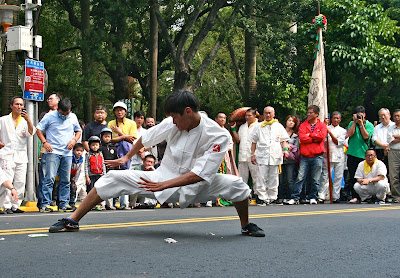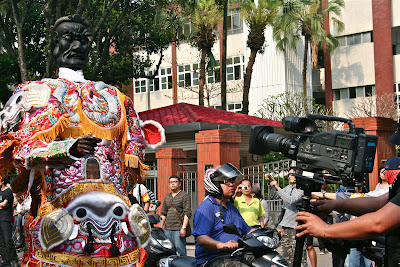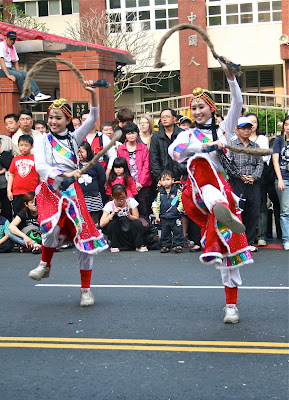After finding that my class at noon is postponed, I read a bit of the Washington Post and came across this article:
Tel Aviv's Abundance of Bauhaus Architecture
Bauhaus is not my favorite style - I'm a fan of Art Nouveau and that Japanese brick-and-cement colonial "baroque" style, especially when it's combined with Chinese and Japanese elements in its doorways, windows and flourishes - but even I've noticed a few Bauhaus-inspired buildings dotting Taipei's landscape. That got me thinking.
Just as Tel Aviv should be renovating and rehabilitating its architectural motherlode, so should Taipei. This isn't the first time I've had this thought, or probably even the first time I've blogged about it, but I believe it sincerely. We shouldn't be tearing down everything in sight - the KMT idiots did that from the '50s onward, destroying forever some of Taipei's greatest architecture, which could have been a major tourism draw now had it been allowed to stand (and the city expanded in different ways). Sure, in that time some other interesting stuff went up, but most of it was hideous. Instead, a government program to help property owners renovate buildings of architectural significance would be, if not a replacement for urban renewal projects, at least a complement to it, a program to run alongside it.
With the Shilin Wang family case still somewhat in the news (it's still going strong among my Taiwanese Facebook friends but seems to be dying down in the English media), urban renewal has been on everyone's mind. While I generally tend to side with people like the Wangs, some part of me does feel that if your building is not historically or architecturally significant, and a project is going through to improve a community, it might well be in that community's best interests to just make it happen - as long as compensation is fair and inconvenience and upheaval are kept to a minimum. Generally, I don't have a clear opinion on the topic, and I've heard differing reports on the age of the buildings razed (the newspapers are now saying decades-old. I heard one almost certainly false report that they were 134 years old).
I mean, there's a lot of ugliness in Taipei that could be improved. I'm mostly in favor of preserving vintage architecture, but I'm not against attractive modern buildings going up, and definitely not against some of the monstrosities of Taipei being torn down. Prague has done a remarkable job of melding modern with historically significant, as has New York.
 |
| Honestly, most of this can just be torn down for all I care. Build something nicer. |
It's tough, though, to make a judgment call on what's worth saving. For example, I find old two-colored tile facades to be quirky and interesting, and worth preserving despite their often dingy appearance:
 |
| Keep it. |
But anything that's a bare expanse of cement, or has a tin roof, can go:
 |
| Raze it! I like the eye graffiti though. |
All in all, I think two things:
1.) The Taipei City government has done a middling-to-bad job of architectural preservation (although they're improving - I have seen a visible rise in the number of interesting buildings being renovated and fewer are being torn down) and a terrible job of urban renewal: just ask the Wangs. What goes up in these projects is not likely to be much better than what's being torn down. There are so many architecturally interesting, but somewhat dilapidated, buildings in Taipei. A lot of people could be housed in those buildings were they to be renovated, which wouldn't solve the problem entirely, but it would make a dent in it.
That said, I disagree with the
general derision heaped upon public housing. I live in public housing, and it's fine. Then again it was built for veterans and is not "low income", at least not now. People here range from middle class to quite wealthy, with only a few working class families around. Not that I'm anti-working class: I loved living in working-class Jingmei even though I hated my apartment. I'm just stating a fact. My public housing building boasts good insulation, stays cooler on warm days and warmer on cool days, has had far fewer problems than our apartment in Jingmei did, and services in the area abound - including a very low management fee and an on-call plumber at low rates. The buildings are ugly but not the ugliest in Taipei, and residents have improved them with flowers and window casements. Our walls have a few issues - the brightly colored paint on our walls revealed several building flaws, including sweating pipes and weird seams - and we can hear our upstairs and downstairs neighbors, but generally I'm happy with the place.
and
2.) I hear a lot of bitching from the expat community on how ugly cities in Taiwan are. Yes, most of them are pretty horrible, especially the medium-sized cities in the counties, but I don't get all the whining about how ugly Taipei is. OK, fine, it's not Prague and it's not the best of New York, and it's got some really horrible buildings (from ones made of corrugated metal to hulking concrete monstrosities), but it's got a lot of gems, too, and a lot of quirky style. You just have to look. If anything, Taizhong is a much uglier city, albeit with better weather.
Maybe it's that recently I've been feeling more annoyed than usual at foreigners complaining incessantly about Taiwan: I feel some amount of blowing off steam is fine, even necessary, but when I hear someone just go
on and on and freakin' on about what he doesn't like (it's usually a "he", but women certainly can do it too), I have to wonder. If it's so bad, why don't you leave? You don't have to move home. Find another country. If you don't like it so much, why are you still here? And if you have a good reason to be here (study, job opportunities unavailable elsewhere, family), wouldn't you be better off looking for the positives instead of harping on the negatives? There are negatives - even I, ever the Taiwan-loving optimist - know that, but there are some really great things that balance them out or at least make them something you don't need to focus on so much. For every hideous building there's a hidden gem. For every rude person there's a friendly one. For every difficult encounter there's a lovely surprise. And, most of the time, I find the positives outweigh the negatives. I can understand hating China - I spent a year there and left because I wasn't happy and was constantly sick - and to some extent I can see how extreme culture shock could render some to hate Korea, and the insular and overly polite nature of Japanese society could destroy someone's faith in Japan, but I don't see what's so bad about Taiwan that it deserves such kvetching. Even India, which I love, offers a lot of good material for the complainer to latch onto. But Taiwan?
Anyway, back to architecture. If you think Taipei is ugly, fine. I think the weather sucks, so we're even. If you think it's ugly enough that it warrants repeated comments - and not the kind where you laugh it off as I do the weather - why are you still here?
Sure, so many buildings in Taipei are so unrelentingly hideous that they should just be razed:
 |
Seriously, this thing is horrible. You could make a case for painting it with funky murals
but it's probably best to just get rid of it. |
Some have been lovingly restored (and others half-heartedly):
 |
| They could do better with this one. So much potential. |
 |
| This set of buildings on Dihua Street is fairly well-known |
 |
This is one of my favorite window facade
And some are functional/restored, but seem to be noticed by nobody but me:
|
 |
| For example, this is my dream house (although I'd prefer it not be right on Yanping Road), but it seems to be largely ignored. |
 |
| This funky old building and ones like it are easy to miss, but lovely when you're looking for them and worthy of being kept in good condition. |
 |
| Interestingly tiled buildings with curved or unusual facades abound - also worth saving |
 |
| This one on Guiyang Street is a little more well-known but is still largely ignored |
 |
| This one, too, on the north-central end of Yanping |
 |
| This is on or near Hengyang Road, which has many gems |
 |
| By 228 Park |
 |
| Whereas still others have not only been restored but have become art installations |
 |
| These are not doing badly |
And yet still others are barely hanging on, and in desperate need of renovation:
 |
| A few interesting shophouses in the area between Ximen and Longshan Temple |
 |
| I'd love to see this Guiyang Street building renovated |
I realize that I took most of these in the older parts of Taipei - Wanhua, Dadaocheng. They were just the most accessible photos, though. There are all sorts of buildings dotting Taipei that are not in those areas: Chang'an and Zhongshan boasts at least one true gem and a few other interesting tidbits. Heping E. Road just west of Guting has a few. Jingmei has one crumbling facade down by Shi Hsin University that deserves a renovation, half a three-sided farmhouse attached to a building and a few alleys of old shophouses. There is some really funky, almost Bauhaus stuff you can still see around Raohe Night Market. There's a totally fascinating dark cement Gothic-looking building in the lanes near Jianguo N. Road, just north of Nanjing. I wish National Taiwan University would renovate its old Japanese buildings. In the far west of the city, in the no-man's land by the river northwest of Ximen and southwest of Dihua Street, even farther west than the old warehouses that are being renovated, are some gems of Japanese wooden houses that deserve renovation, even if newer buildings that can house more people go up around them. Even my neighborhood - central Da'an - has a few two-color tile buildings that look vintage 50s and 60s that would be worth a good scrub and a renovation. Xinyi has a few still standing out behind the cabbage farm near Taipei 101 (is that still there? I haven't been out that way in awhile). Changchun Road has a few interesting buildings worth seeing, Minsheng Community on Sanmin Road has a cool curved brick building, Qiyan has some interesting old warehouse spaces, Roosevelt has some lanes around Guting - mostly to the north but a few to the south - that have stuff worth looking at. Bade as you head east has some weird, cool stuff going on amidst the ugliness, and old temples and shrines from Taipei's farmland days dot the landscape.
These buildings dot the city, even if they're concentrated in the west.
So...why aren't we saving them? Why are they falling apart? Why are they often uninhabited? If the owners can't afford to fix them up, why is the government pouring money into monstrosities like the Yuanhuan Circle "food court" and not into helping the owners make their properties functional and beautiful again?









































































































